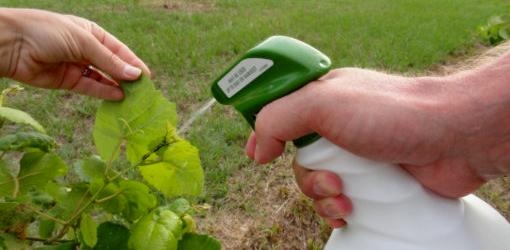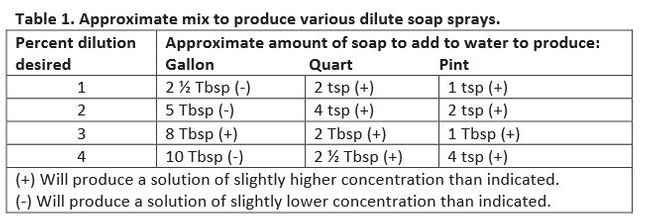By Scott Oneto, Farm Advisor, University of California Cooperative Extension
Soaps have been used to control insects and combat pests for hundreds of years, but their effectiveness as pesticides has been scientifically established only recently. Recently, there has been increased interest in and use of these products. This change is due to a better understanding of how to use soaps most effectively and a desire to try insecticides that are easier and safer to use than many currently available alternatives.

How soaps and detergents kill insects is still poorly understood. Researchers have been studying how soaps work in combating pests. Some soaps simply wash off the outer waxy coating of the insect's cuticle, destroying its watertight quality and causing the insect to dry up and die. Other soaps have additional insecticidal properties that may affect the nervous system. These soaps appear to have toxic effect only against plant-eating insects and thus may spare beneficial insects such as ladybird beetles (ladybugs), lacewings, and predatory mites. In addition, high pressure sprays may wash some insects off the plant and other insects may be immobilized in soapy water, making them easier to rinse off the plants.
Soaps will kill many insect pests, including aphids, mealybugs, whiteflies, spittlebugs, rose slugs, and soft scale on most houseplants, ornamentals, and fruit trees. But because soaps have little or no residual action, sprays should be applied at regular intervals until the population is controlled or eliminated.
Soaps act strictly as contact insecticides, with no residual effect. To be effective, sprays must be applied directly to and thoroughly cover the insect. Several insecticidal soaps are available over-the-counter for control of insects and mites. Available under a variety of trade names, the active ingredient of all is potassium salt of fatty acids. Insecticidal soaps are chemically similar to many household liquid hand soaps. However, there are many features of commercial insecticidal soap products that distinguish them from the dish washing liquids or liquid hand soaps that are sometimes substituted.
Insecticidal soaps sold for control of insects:
- are selected to control insects
- are selected to minimize potential plant injury
- are of consistent manufacture
Some household soap also makes effective insecticides. In particular, certain brands of hand soaps and liquid dishwashing detergents can be effective for this purpose. They are also substantially less expensive. However, there is increased risk of plant injury with these products. They are not designed for use on plants. Dry dish soaps and all clothes-washing detergents are too harsh to be used on plants. Also, many soaps and detergents are poor insecticides. Identifying safe and effective soap-detergent combinations for insect control requires experimentation. Regardless of what product is used, soap-detergent sprays are always applied diluted with water, typically at a concentration of around2 to 3 percent. (Table 1)
One of the most serious potential drawbacks to the use of Household soap-detergent sprays is their potential to cause plant injury –their phytotoxicity. Certain plants are sensitive to these sprays and may be seriously injured. For example, most commercial insecticidal soaps list plants such as hawthorn, sweet pea, cherries and plum as being sensitive to soaps. Certain tomato varieties are also sometimes damaged by insecticidal soaps. The risk of plant damage is greater with homemade preparations of household soaps or detergents. When in doubt, test soap-detergent sprays for phytotoxicity problems on a small area a day or two before an extensive area is treated.
Plant injury can be reduced by using sprays that are diluted more than the 2 to 3 percent suggested on label instructions. To reduce leaf injury, wash plants with in a couple of hours after the application. Limiting the number of soap applications can also be important, as leaf damage can accumulate with repeated exposure.
However, because of the short residual action, repeat applications may be needed at relatively short intervals (four to seven days) to control certain pests, such as spider mites and scale crawlers. Also, application must be thorough and completely wet the pest. This usually means spraying undersides of leaves and other protected sites. Insects that cannot be completely wetted, such as aphids within curled leaves, will not be controlled.
Environmental factors also can affect use of soaps. In particular, soaps (but not synthetic detergents) are affected by the presence of minerals found in hard water, which results in chemical changes producing insoluble soaps (soap scum). Control decreases if hard-water sources are used. Insecticidal soaps may also be more effective if drying is not overly rapid, such as early or late in the day.
Soaps and detergents can offer a relatively safe and easy means to control many insect pests. As with all pesticides, however, there are limitations and hazards associated with their use. Understand these limitations, and carefully follow all label instructions.
